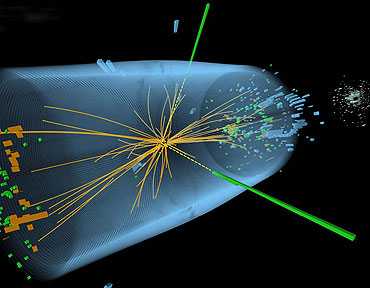Dec 1 2012
You might call the Higgs boson the media darling of particle physics.
 econstruction of a Higgs-like particle decaying into two photons (the carrier of the electric and magnetic forces). (Image: THE COMPACT MUON SOLENOID COLLABORATION)
econstruction of a Higgs-like particle decaying into two photons (the carrier of the electric and magnetic forces). (Image: THE COMPACT MUON SOLENOID COLLABORATION)
The subatomic particle’s discovery earlier this year made headlines around the world, with news outlets from CNN to Bloomberg and Scientific American reporting on the achievement.
Why all the fuss?
To find out, members of the UB community can attend HiggsFest, a celebration of the Higgs boson that the Department of Physics is hosting at 5 p.m. Dec. 6 in 205 Natural Sciences Complex, North Campus.
The event’s organizers include five UB physicists who contributed to the study of the particle: Professor Doreen Wackeroth; Associate Professors Ia Iashvili, Avto Karchilava and Dejan Stojkovic; and Assistant Professor Sal Rappoccio, who joined the UB faculty this semester from Johns Hopkins University.
HiggsFest will include short presentations on the significance of the Higgs boson find. The event flyer professes that these talks will take place in “plain English.”
Guests also will be able to take a look at a tiny particle detector and tinker with an interactive graphic illustrating the particle-collision experiment that led to the discovery of the Higgs boson. Kids who attend will enjoy physics-related craft activities.
The Higgs boson is a subatomic particle that helps explain why objects have mass. The particle is a crucial piece of the Standard Model of particle physics, which physicists use to describe how the world around us works. As Rappoccio explains, “Without something like this particle, electrons don’t have mass, so there are no atoms and there’s no life. This is a large piece of the puzzle for existence.”
For many years, the Higgs was the only particle in the Standard Model that researchers were unable to observe.
That changed this summer when scientists at the world’s most powerful proton smasher reported seeing a particle that looked tantalizingly like the Higgs. At a conference in Japan earlier this month, experts presented further evidence that the particle was indeed the long sought-after boson.